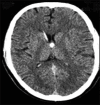Interhemispheric transcallosal transforaminal approach and its variants to colloid cyst of third ventricle: Technical issues based on a single institutional experience of 297 cases
- PMID: 27366259
- PMCID: PMC4849301
- DOI: 10.4103/1793-5482.144185
Interhemispheric transcallosal transforaminal approach and its variants to colloid cyst of third ventricle: Technical issues based on a single institutional experience of 297 cases
Abstract
Context: Colloid cysts are benign intracranial lesions that usually involve the anterior third ventricle with varying appearance on imaging studies. The number of articles debating the origin of this tumor is surpassed by papers proposing the best modality available for its treatment.
Aim: The purpose of this study is to analyze the clinical presentation and surgical outcome of colloid cysts surgically managed over a period of thirty-two years and evaluate the technical issues based on our experience.
Study design: This is a retrospective case series study.
Materials and methods: This is a retrospective case series study on 297 consecutive patients with colloid cysts who were operated. The case records of all the patients were evaluated to record the clinical symptoms and signs, imaging findings, surgical procedure, complications and follow-up data.
Results: There were 178 (60%) males and 119 (40%) females, their age ranging from 9 to 66 years with a mean age of 28 years. The mean duration of symptoms was 1.8 months. Raised intracranial pressure headache was the most common initial presenting symptom followed by visual blurring, memory disturbance and drop attacks with gait unsteadiness. The tumor was an incidental imaging finding in five patients (2%). While an interhemispheric transcallosal approach was used in 275 (92.6%) patients, it was trans-cortical in 22 (7.4%). Twenty-two patients required emergency surgery in view of worsening sensorium. Postoperative complications included memory impairment, limb weakness and seizures. Despite documented complete excision of the tumor in 6 cases, 8 patients had recurrence of tumor during follow-up.
Conclusion: Colloid cysts are potential life threatening but benign lesions that can be removed safely with low morbidity and mortality through the interhemispheric transcallosal approach and its variants. The possibility for recurrence warrants, close imaging follow-up after surgery. It is essential for neurosurgeons to be familiar with the different transcallosal approaches to reach the third ventricle especially for a posteriorly situated cyst and a narrow foramen of Munro.
Keywords: Colloid cyst; hydrocephalus; intraventricular tumor; transcallosal surgery.
Conflict of interest statement
Figures



References
-
- Laidlaw J, Kaye AH. Colloid Cysts. In: Kaye AH, Laws ER Jr, editors. Brain Tumors. New York: Churchill Livingstone; 1995. pp. 907–19.
-
- Ho KL, Garcia JH. Colloid cysts of the third ventricle: Ultrastructural features are compatible with endodermal derivation. Acta Neuropathol (Berl) 1992;83:605–12. - PubMed
-
- de Witt Hamer PC, Verstegen MJ, De Haan RJ, Vandertop WP, Thomeer RT, Mooij JJ, et al. High risk of acute deterioration in patients harboring symptomatic colloid cysts of the third ventricle. J Neurosurg. 2002;96:1041–5. - PubMed
-
- Pollock BE, Schreiner SA, Huston J. A theory on the natural history of colloid cysts of the third ventricle. Neurosurgery. 2000;46:1077–83. - PubMed
-
- Ganti SR, Antunes JL, Louis KM, Hilal SK. Computed tomography in the diagnosis of colloid cysts of the third ventricle. Radiology. 1981;138:385–91. - PubMed
LinkOut - more resources
Full Text Sources
Other Literature Sources

